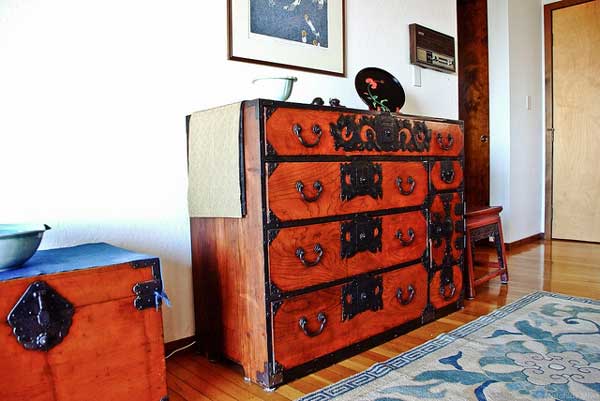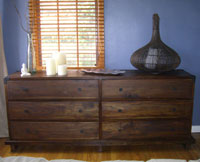Tansu is a traditional style of Japanese furniture that are designed to be mobile storage cabinets. The word “tansu” is used to refer to Japanese furniture in a general sense but has a literal translation meaning “chest” or “container.” Made using traditional hand woodworking tools, tansu furniture has been perfected as an art form throughout the centuries.
Handcrafted by tansuyas (tansu craftsmen), tansu is connected to many different types of Japanese furniture. Tansu places an emphasis on functional use over the aesthetic design. It’s bold and powerful presence captures an era known for samurais and traditional Japanese nobility. The focus on ergonomics is different in the sense that the functional use caters to a unique need; the need to be mobile and easy to transport.

(CC)
Common Characteristics of Tansu Furniture
- All tansu furniture hold two qualities in common; it is mobile and functional.
- Heavy iron hardware.
- Minimalist Design with straight lines and little ornate detailing.
- Hardware was functional because iron was forged at this point in time.
- Does not have legs.
- Made from soft and hard woods; Keyaki (elm), Kuri (chestnut), Ezo Matsu (pine), Sugi (cedar), Kiri (paulownia), and Hinoki (cypress).
- Rich wood grains.
- Coated in a dry or lacquered finish.
Tansu embodies the exotic appeal of handcrafted Asian furniture while filling the need for highly mobile storage units. Tansu furniture often uses iron, a status symbol in Japanese culture and often associated with prominence and nobility. Once you understand the common features of tansu furniture, you’ll instantly be able to distinguish tansu furniture from other types of cultural furnishings around the world.






 For the bed side table we love the matching Tropical nightstand but chose the
For the bed side table we love the matching Tropical nightstand but chose the 